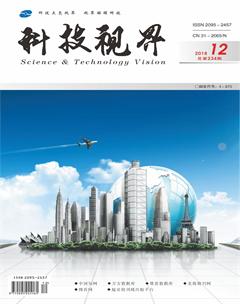Pt掺杂锐钛矿TiO2(001)面的第一性原理研究
王应 李宗宝 李勇
【摘 要】基于Pt掺杂锐钛矿TiO2(001)面的最稳定结构,采用第一性原理计算了铂掺杂锐钛矿体系在(001)表面的形成能,通过形成能的比较得出了Pt掺杂TiO2(001)表面最佳掺杂位置及掺杂结构;再进一步通过对掺杂后原子态密度和能带结构的计算,综合分析了铂掺杂锐钛矿体系在(001)表面有利于提高锐钛矿TiO2的光催化氧化效率。
【关键词】锐钛矿TiO2;Pt掺杂;形成能;第一性原理
中图分类号: O643.36;TM911.4 文献标识码: A 文章编号: 2095-2457(2018)12-0114-002
DOI:10.19694/j.cnki.issn2095-2457.2018.12.049
Study on the first principle of TiO2(001) surface in Pt - doped anatase
WANG Ying 1 LI Zong-bao2 LI Yong1
(1. College of big data, tongren university,Tongren 554300,Guizhou;
2. School of materials and chemical engineering, tongren university,tongren 554300,guizhou)
【Abstract】based on Pt doping anatase TiO2(001), the most stable structure, using the first principles calculation platinum doping in anatase system(001) formed on the surface of the can, through the comparison of formation can be obtained the Pt doping TiO2(001) surface of the optimal doping position and structure; Furthermore, by calculating the atomic density and energy band structure after doping, the photocatalytic oxidation efficiency of TiO2 at the surface of platinum-doped anatase system(001) was comprehensively analyzed.
【Key words】TiO2 of anatase; Pt doping; Can form; Primary principle
0 引言
目前大城市大气环境污染源主要是大量汽车排放碳氢化合物、一氧化碳和氮氧化物等有害物质,严重危害着人们的身体健康,并且制约了城市经济的发展。因此,处理大气中污染物的热催化氧化处理成本太高,吸附是目前较好的处理方法。纳米二氧化钛凭借其价格低廉、制备工艺选择性多、耐酸碱、稳定性高、无毒、绿色环保和杀菌性等优点在半导体光催化材料中脱颖而出[1-3]。根据前人的研究TiO2晶型[4]有金红石相、锐钛矿相和板钛矿相三类,但是锐钛矿相TiO2的稳定性最强、光催化效果也是最佳[5-7]。但纳米二氧化钛光响应范围较窄,只能在近紫外光区受激发产生光生电子-空穴对,对太阳光的利用率极低,同时光生电子-空穴对极易复合,因而极大的限制了其在现实生产生活中的应用[8]。而金属Pt因其与氧化钛界面间存在金属-载体强相互作用而引起了人们的广泛關注[9-10]。在氧化钛表面担载少量的铂可以明显地改善氧化钛的化学吸附及光催化性能[11-15]。本课题组研究发现Pt掺杂TiO2体系对烃类的催化氧化是紫外光子的吸收导致了电子-空穴对的产生,与前人的实验结果吻合较好。
1 计算方法(物理方法与模型)
本文几何优化部分采用 Materials Studio软件,电子性质计算部分采用 Materials Studio中的 CASTEP 模块进行。在倒格矢空间,平面波截断能取400 e V,K点取为 3×3×1,构建3×2的超晶胞结构,在进行优化过程中,除顶层原子和掺杂的Pt的外,其它原子位置均固定。
Pt掺杂TiO2体系中吸附能的计算公式定义如下:
其中,Eform为Pt表面掺杂TiO2(001)面能量,Edoped为总能量,Epure为TiO2(001)面能量,EPt为Pt的能量。从上述计算公式中计算得的最低能量状态为Pt掺杂后最稳定状态。
2 能带结构和电子态密度
为了进一步分析Pt掺杂TiO2(001)表面的电子结构,利用结构优化后所得到的参数计算了掺杂前后锐钛矿型TiO2(001)表面的能带结构。计算结果如图2和如3所示。
(1)从图2可看出未掺杂的锐钛矿型TiO2禁带宽度小于文献报道的3.2eV,但计算结果不影响Pt掺杂锐钛矿型TiO2电子结构出现变化规律的分析。比较图2和图3发现,Pt掺杂后,出现一条杂质能级与平衡时费米能级重合现象,这体现了Pt的掺杂最有利于陷阱作用;在导带底和价带顶位置下移较大。
(2)从Pt掺杂锐钛矿型TiO2(001)面前后的态密度如图4和图5明显看出Pt掺杂锐钛矿型TiO2(001)面后的态密度坐标整体下移较大,产生了导带位置负移现象很大,说明Pt掺杂锐钛矿型TiO2(001)面后缩小了TiO2(001)面的带隙。这有利于使光空穴产生迁移现象的发生。
3 结论
金属Pt掺杂在TiO2(001)表面有利于陷阱作用,缩小了TiO2(001)表面的带隙,有利于促使光生空穴产生迁移现象,能减少电子和空穴的再次复合机会,从而增加了有效的光生电子和空穴数量,增强锐钛矿型TiO2催化剂的催化氧化活性。
【参考文献】
[1]高镰,郑珊,张青红.纳米氧化钦光催化材料及应用[M].北京:化学工业出版社,2005.
[2]WANG J, SUN W, ZHANG Z H,et al. Sonocatalytic degradation of methyl parathion in the presence of micron -size and nano- sized rutile titanium dioxide catalysts and comparison of their sonocatalytic abilities[J]. Journal of Molecular Catalysis A: Chem -ical, 2007, 272(1): 84-90.
[3]KEI I, TAKASHI K, MASATAKA, et al. Direct nanocomposite of crystalline Ti O2particles and mesoporous silica as a molecular selective and highly active photocatalyst[J]. Chemical Communi -cations, 2005(3): 2131-2133.
[4]WANG P,GRATZE M. A stable quilsi-solid-stilte dyesensitized solar cell with an amphiphilic ruthenium sensitizer and polymer gel electrolyte[J].Nature Materials,2003,21:402-427.
[5]HAGFELDT A,GR TZEL M.Light-induced redox reactions in nanocrystalline systems[J].Chem Rev,1995.
[6]MILLS A,HUNTE S L.An overview of semiconductor photocatalysis[J].J Photoch Photobio: A,1997,108:1-35.
[7]馮华杰,孙振范,陈六平,等.浓度对 Fe 掺杂 TiO2的影响的第一性原理研究[J].中山大学学报:自然科学版,2013,52(2): 74-78.
[8]MIAO Y, WU B H, ZENG G W, et al. Relation between changes in ultrastructure and composition of cell wall and calcium -related physiological disorder of Chinese cabbage[J]. Acta Phytophysio-logica Sinica, 2000, 26(2): 111-116.
[9]Haller, G. L.; Resasco, D. E. Metal support interaction-group-viii metals and reducible oxides. Adv. in Catal., 1989, 36: 173-235.
[10]Tauster, S. J. Strong metal-support interactions. Accounts of Chem. Res., 1987, 20: 389-394.
[11]Choi, W.; Lee, J.; Kim, S.; Hwang, S.; Lee, M. C.; Lee, T. K. Nano Pt particles on Ti O2and their effects on photocatalytic reactivity. J. Ind. & Eng. Chem., 2003, 9: 96-101.
[12]Gan, S.; Elazab, A.; Liang, Y. Formation and diffusion of Pt nanoclusters on highly corrugated anatase Ti O2(001)-(1x4) surface. Surf. Sci., 2001, 479: L369-L374.
[13]Gan, S.; Liang, Y.; Baer, D. R.; Grant, A. W. Effects of titania surface structure on the nucleation and growth of Pt nanoclusters on rutile Ti O2(110). Surf. Sci., 2001, 475: 159-170.
[14]Sun, B.; Vorontsov, A. V.; Smirniotis, P. G. Role of platinum deposited on Ti O2 in phenol photocatalytic oxidation. Langmuir, 2003, 19: 3151-3156.
[15]Vannice, M. A.; Poondi, D.The effect of metal-support interactions on the hydrogenation of benzaldehyde and benzyl alcohol. J. Catal., 1997, 169: 166-175. 59-63.

